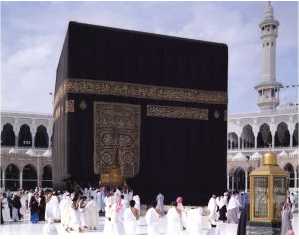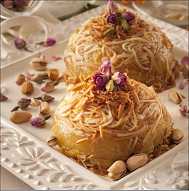|
The Feel-Good Guide to Sports, Travel, Shopping & Entertainment
|
| Main | Sports Events | Holidays & Observances | Pop Culture | Shopping | Travel |
|
MAIN
Eid ul-Adha (pronounced (eed ul ud-ha) is celebrated every year on the 10th day of the month of Dhul Hijja on the lunar Islamic calendar. Second only in importance to Ramadan, Eid ul-Adha is a time of feasting and family get-togethers, gift giving and special prayers that commemorate Abraham's near-sacrifice of his son to prove his obedience to Allah. The holiday is additionally observed by the symbolic sacrifice of a sheep or calf, with a generous portion of the meat given to the poor as an act of charity. "Eid Murbarak!" (holiday blessings!) is the traditional greeting among the faithful during the Eid ul-Adha, the Festival of Sacrifice.
While non-Muslims may not be as familiar with Eid ul-Adha, the pilgrimage associated with the holiday is famous throughout the world. During the Hajj, rich and poor alike gather to circumambulate a huge monolith, the Kaabah, to signify oneness with the faith. Stoning the devil is another ritual performed in an effort to renounce the material world and ultimately experience spiritual rebirth.
• The greeting during Eid ul-Adha, "Eid Mubarak" is pronouncewd Eeed Mooo-Barack. Eid means "holiday" or “celebration” and Mubarak means “blessed”, which literally translates to have a blessed holiday. • On the first day of the celebration, Muslims visit local mosques for their morning prayers. but when returning home they must take a different route than they normally do. (No one knows exactly why. It's tradition!) • Eid ul-Adha is similar to Christmas or Easter, and includes the wearing of new clothes, exchanging gifts, eating traditional holiday foods and attending special services at the Mosque with family members. • Eid-ul-Adha is also called "Salty Eid" for the large variety of savory dishes served as the main meal. These may include beef or mutton or shish kebab in the Mideast, or popular rice dishes such as Biryani in Southeast Asia. Traditional desserts call for sweet pastries flavored with pistachio, almond or walnut. During Eid ul-Adha, like most holidays, you are sure to gain a few extra pounds!
On the Web, discover more about Eid ul-Adha and the Hajj, including more on their history and meaning told in virtual tours and photo galleries, kid-friendly teaching resources, along with e-cards to send in honor of the festival that reaffirms the faith among millions of Muslims worldwide ...
Eid ul-Adha - Extensive Wikipedia guide with information on the history, traditions and prayers of the celebration as observed in Saudi Arabia, India, Pakistan, Indonesia, Turkey and other Islamic countries with a related calendar, references & resources. Virtual Hajj - A map & photo tour depicting the journey to Mecca with virtual stops in Mina, the Mount of Mercy, Muzdalifah, and information on traditional rites and customs. |


